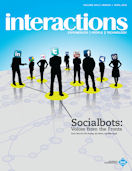Authors:
Amanda Williams, Alicia Gibb, David Weekly
Let's be honest. Much of what we do as researchers in tangible interaction design is hacking. We reappropriate game controllers; we break open toys and cannibalize their parts; we bend and flex and stuff electronics into objects they were never meant to go into. We usually mention this hackery, briefly, in the implementation sections of our research papers and then move on to discuss their interactional affordances, which is where our innovation really lies, right? In this article, we will discuss the ways in which hacking and hackers [1] make our world go round. Widespread use of open source…
You must be a member of SIGCHI, a subscriber to ACM's Digital Library, or an interactions subscriber to read the full text of this article.
GET ACCESS
Join ACM SIGCHIIn addition to all of the professional benefits of being a SIGCHI member, members get full access to interactions online content and receive the print version of the magazine bimonthly.
Subscribe to the ACM Digital Library
Get access to all interactions content online and the entire archive of ACM publications dating back to 1954. (Please check with your institution to see if it already has a subscription.)
Subscribe to interactions
Get full access to interactions online content and receive the print version of the magazine bimonthly.







Post Comment
No Comments Found